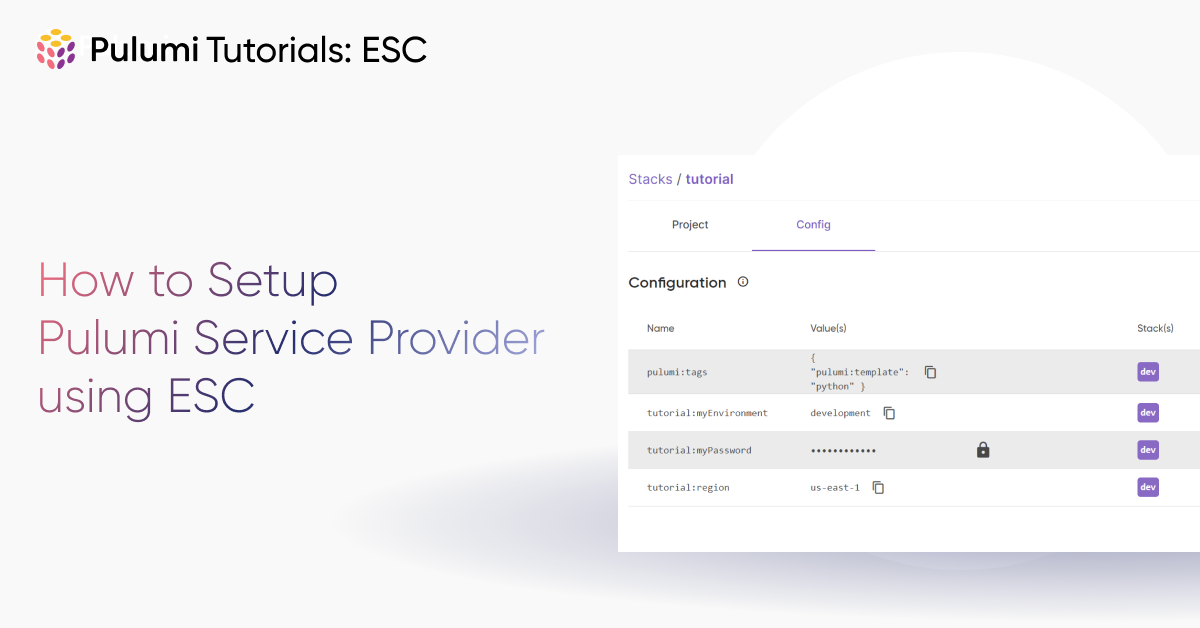Setup Pulumi Service Provider using ESC

In this tutorial, you'll learn:
- How to store and retrieve configuration values with Pulumi ESC
- How to configure Pulumi Service Provider
- How to use Pulumi Service Provider to create more ESC Environments
Prerequisites:
- Basic understanding of Pulumi IaC
- The Pulumi CLI installed
- A Pulumi Cloud account and access token
- Familiarity with TypeScript and Node.js
Log into Pulumi Cloud
Before you begin, make sure you’ve signed into Pulumi Cloud. Once you’ve done so, you can log in with Pulumi CLI and be prompted to :
$ pulumi login
Manage your Pulumi stacks by logging in.
Run `pulumi login --help` for alternative login options.
Enter your access token from https://app.pulumi.com/account/tokens
or hit <ENTER> to log in using your browser
Obtain a personal access token
Next, you’ll also need a Pulumi Cloud personal access token. Create a short-lived access token for this tutorial and copy it into your current shell to login into Pulumi Cloud. Be sure to keep track of this token as you will need it for the next step of the tutorial.
Brief Explanation
Pulumi Service Provider (PSP) is a Pulumi provider for creating and configuring Pulumi Cloud resources using Pulumi IaC Programs. Just like an S3 bucket is created using an AWS provider, PSP allows creation of things like Environments, Environment Version Tags, Environment Webhooks, and much more. In order to authenticate with Pulumi Cloud, PSP uses the same personal access token (PAT) as Pulumi CLI. This is where ESC comes in!
Instead of providing the PAT as an environment variable, risking losing or leaking it, we will create an ESC Environment and store the PAT there. We will then import this environment into the configuration of a new stack, in which we will create Pulumi Cloud resources
Create a new ESC environment
ESC Environments are a great way to store configuration settings and secrets. Environments can be created in the Pulumi Cloud console or with the CLI.
To get started, navigate to the Environments page using Pulumi Cloud console’s navigation bar on the left. Then click Create Environment button, fill in creds for project name and psp for environment name and click Create. You will now see a blank new environment with some default commented-out explanations.
Fill in the PAT
Select everything in the Environment definition pane and replace it with this:
values:
pulumiConfig:
"pulumiservice:accessToken":
fn::secret: % FILL IN PAT HERE %
"pulumiservice:apiUrl" next to the accessToken one. Fill it with your Pulumi Cloud backend URL. This is not needed for most users.Once you fill in your previously created PAT, click Save on the top right. This will update your new environment’s definition with the values you just added. Note that the plaintext PAT was converted into a secret value. It is now securely stored within Pulumi Cloud, removing the risk of losing or leaking the PAT, while your stacks are still able to decrypt and use it. Feel free to erase the plaintext PAT, we won’t need it again!
Create a new Pulumi Program
Now it’s time to create a new Pulumi Program that will use the new Environment and PSP to create more Pulumi Cloud resources!
Create a new folder in your shell (for example esc-psp-tutorial) and navigate into it. Then, run pulumi new, and navigate the menu to create a new stack from a template called typescript. Fill in the project name as esc-psp-tutorial, and the stack name as %ORG NAME%/dev, filling in your actual organization name (for the rest of the tutorial, tutorials will be used), and dev as the name of the new stack.
Once Pulumi CLI finishes installing dependencies, you should see the following files in your tutorial folder:
Pulumi.yaml index.ts node_modules package-lock.json package.json tsconfig.json
Import the ESC Environment into the IaC stack
In your tutorial folder, create a new file Pulumi.dev.yaml. This file will contain configuration specific to your new dev stack. Fill the file in with this:
environment:
- creds/psp
Here, environment field lets you specify an array of ESC Environments to import. In this case, we only want to import the Environment we created above, creds/psp, where creds is the ESC project name and psp is the Environment name.
Write the Pulumi program
Open your new project in an IDE of your choice. Replace the code in index.ts with the code below:
import * as service from "@pulumi/pulumiservice";
import * as pulumi from "@pulumi/pulumi";
let config = new pulumi.Config();
var environment = new service.Environment("environment-from-psp", {
organization: "tutorials",
project: "esc-psp-tutorial",
name: "first-psp-environment",
yaml: new pulumi.asset.StringAsset(
`values:
esc-mastered: true
psp-mastered: true`
)
})
Remember to replace tutorials with your actual organization name.
Now, to be able to use PSP, run npm install @pulumi/pulumiservice to install the plugin. (Your command will differ if you’re not using npm as Node’s package manager.)
Create a new Environment via IaC
You are now all set! Run pulumi up, and your Pulumi program will create a new environment called first-psp-environment. Navigate to the Environments page in Pulumi Cloud console to confirm it exists. You should be able to see the environment definition from your code - both esc-mastered and psp-mastered values are now true.
Wrapping up
You have learned how to create ESC environments in the Pulumi Cloud console, import them into IaC stacks and even create Environments using the Pulumi Service Provider. The environment you created, creds/psp can now be easily re-used between your stacks, or used to compose more complex environments, using Environment imports. Using what you know now, you can easily create other Environments under the creds project to store credentials for other providers. For example, creds/aws or creds/azure!
